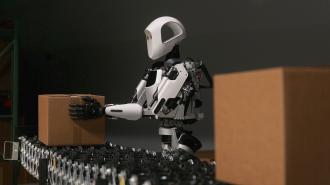Apptronik, a NASA-backed robotics company, has unveiled Apollo, a humanoid robot that could revolutionize the workforce — because there’s virtually no limit to the number of jobs it can do.
“The focus for Apptronik is to build one robot that can do thousands of different things,” Jeff Cardenas, the company’s co-founder and CEO, told Freethink. “The best way to think of it is kind of like the iPhone of robots.”
The challenge: Robots have been automating repetitive tasks for decades — instead of having a person weld the same two car parts together 100 times a day, for example, an automaker might just add a welding robot to that segment of the assembly line.
A single robot that can handle many different tasks — aka, a “general-purpose” robot — could be revolutionary for workplaces outside an assembly line, but creating such a bot, at a cost that makes sense to employers, has proven to be a huge challenge.
What’s new? Apptronik believes it has managed this seemingly impossible feat of engineering with Apollo — not only is it the “most capable” humanoid robot ever created, according to the company, but it was also specifically designed to be mass manufactured and cost effective.
“The goal for Apollo is to produce a humanoid robot for less than the price of many cars, so think of it as being parity with a car a standard family would have long term,” said Cardenas.
Apollo’s swappable batteries mean the bot itself never needs to be plugged in to recharge.
Robot coworker: Apollo is human-sized — 5’8” tall and 160 pounds — and can walk around on two legs while carrying up to 55 pounds. This could allow it to easily integrate into warehouse settings, where it could potentially move and sort goods alongside other workers.
To ensure the safety of Apollo’s future human coworkers, Apptronik opted to give the humanoid robot electric actuators, which use electricity to trigger movement, rather than a hydraulics system, which would require the use of liquids under pressure.
“In order for a versatile robot to realize its potential, it’s got to be in the real world operating with and around people, and we believe that electric actuation is a key part of that,” Cardenas told Freethink. “We want them to be safe for us to be around.”
Apptronik believes making Apollo look like something people want to be around will help it integrate into the workforce, too, so it gave the bot a friendly face with eye and mouth LEDs for easy communication.
And because no one likes a coworker that’s always on break, Apptronik also gave Apollo swappable batteries. That means the robot itself never needs to be plugged in to recharge — it just needs someone to swap out its battery every four hours.
Looking ahead: Apptronik plans to continue developing Apollo in-house until 2024, when it will launch pilot projects in the field with production models of the humanoid robot before releasing it in late-2024 or 2025.
Though the pilot projects all focus on the same application — case picking — Apptronik sees Apollo developing into bot-of-all-trades, taking a virtually unlimited number of dull, dirty, and dangerous jobs off our plates.
“We believe that Apollo is one of the most advanced tools humanity has ever created,” said Cardenas. “How we apply it will change the way that we live and work.”
We’d love to hear from you! If you have a comment about this article or if you have a tip for a future Freethink story, please email us at [email protected].






